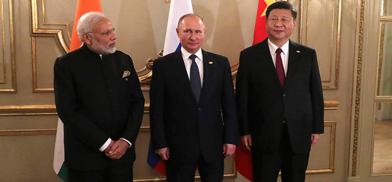Russia, India, China should cooperate to lead the Asian century
RIC, a troika of the three Eurasian powers, can work extensively on issues like counter-terrorism, transnational organised crime, illicit drug trafficking and climate change, writes Samudrala VK for South Asia Monitor

With the power centre of global politics shifting from the West to the East and the rise of multiple power hubs across the Asian region, there is a renewed vibrancy to the concept of the "Asian century". It is against this backdrop that new and acceptable equations of geopolitical and geo-economic domination beginning to unfold. It is up to the major powers in this region to take on the responsibility of building a new regional security architecture.
Although forums like BRICS (Brazil, Russia, India, China, South Africa) and SCO (Shanghai Cooperation Organisation) bring countries like China, India and Russia, key players in the Eurasian region, to lead global politics, the cautious distrust among the trio forestalls the innate bonhomie required to provide an alternative to the existing West- dominant, US-led global order which is characterised by structural inequalities and asymmetry of power.
The recent transformation of the Sino- Russian relationship from enmity to detente, as misgivings between China and Russia take a backseat, provides an opportunity for India to adjust to reality. Here, Moscow acts as a balancing force between China and India in keeping qualms at bay.
RIC - an acronym for the Russia, India, China trilateral grouping - can be considered as a possible counterweight to the western alliance, but is falling behind on a number of parameters, thereby failing to realize its true potential. The purpose and goals of BRICS and SCO are overlapping, which is why RIC fails to see itself as an exclusive distinct entity.
India extended an olive branch to Russia, an all-weather friend, to reinvigorate the time- tested friendship. There has been a lull in the relationship and mutual apathy from both sides, thanks to twin reasons; the1991 reforms, whereby India's dependence on the US has become more pronounced, and the Soviet Union’s disintegration. China, the present-day economic powerhouse of the world, is pushing its own agenda of order across Asia, to exert its influence both economically and politically, which eventually gives it the ability to enforce its priorities across the region. This is where Russia sees India as a means of balancing the Chinese giant.
India, ever since Independence, followed the path of equality, non- aggression, peace and compassion in its foreign policy. Initially, India opted for the non- alignment policy, whereby maintaining equidistance from the two super-power blocs and chalked out an alternative plan for the newly independent third world countries. India, under the banner of third world solidarity, spearheaded the concerns and ambitions of these countries in multilateral organisations such as the United Nations and WTO. With the adoption of market reforms in the 1990s, India shelved non-alignment, but the spirit still resonates in its external outlook. Though Indian diplomacy is tilted towards the US in the post-reform era, the time has come for striking a right balance with multiple players. Meanwhile, the status of India has been transformed from a rule-taker to a rule maker, which exasperates China.
Within the framework of Greater Eurasian partnership, Russia considers India as a crucial player in containing the growing influence of the ferocious 'dragon' As China started to make inroads to Central Asia - a resource-rich region, traditionally under the Russian sphere of influence - with its Belt and Road Initiative (BRI), India has sought to fast track the actual realisation of the International North South Transport Corridor (INSTC), a multi-modal transport network which aims for seamless transfer of freight and improved trade connectivity from Mumbai in India to Moscow, the northern terminus of INSTC. Apart from defence ties, both India and Russia are looking to expand their cooperation in multiple ways. Both, as members of BRICS, a multilateral arrangement among the world's largest emerging economies, are committed to shared prosperity, mutual benefit and non-interference.
Russia's Far East, a region rich in natural resources yet under-developed, is in dire need of investments and manpower. Russia has been looking for trusted allies amid the growing Chinese factor in the region. With the launch of the "Act Far East Policy", India offered a $1 billion line of credit for development of Russia’s Far East. Adding an extra dimension to its existing "Act East Policy", the new plan unveils New Delhi’s intent to engage actively, albeit carefully, to promote its strategic interests in the region. The proposed maritime link between the port cities of Chennai and Vladivostok will not only help India in providing an alternative maritime sea route and in reducing transportation time to reach Russia, but also serves to benefit India’s stand for a “free, open and inclusive Indo- Pacific".
The melting of Arctic glaciers opened up new avenues for Russia in terms of exploring natural resources and shipping lanes. The Chennai- Vladivostok link couples with what is termed as the Northern sea route, which connects East Asia to Western Europe via Russia's far east.
RIC, a troika of the three Eurasian powers, can work extensively on issues like counter-terrorism, transnational organised crime, illicit drug trafficking and climate change. It can steer the reform agenda, according to the current needs, in global institutions like the UN and WTO. RIC would be a potential game-changer in the geo-economic and political fronts if the trio comes on board with a broader consensus and a clear road map. China's cheque book diplomacy has transformed into a policy of intimidation and trapping nations in economic bondage. Beijing must soften its approach to resolve differences with India and Russia.
The US has been looking at India, given its size and stature, as a potential player in the region, to check the hawkish Chinese power. The US wants India to be more assertive and arrangements like QUAD (the quadrilateral of USA, India, Japan and Australia) are part of its long term geopolitical strategy.
The real success of Indian diplomacy depends on how well it can maintain its strategic autonomy in both the continental and maritime security spheres and in designing an independent and sustainable plan of action, while ensuring peace and stability in the region.
(The writer is Director, Centre for Leadership and Governance, Samudrala VK IAS Academy, Hyderabad)










Post a Comment